ACKNOWLEDGEMENT: Deepest Danks to My Mentor and Family Members
59 Pages22682 Words401 Views
Added on 2019-12-18
About This Document
It is, however, in the present context of Uganda where the public-private partnership is being undertaken by a majority of Ugandan firms where the competitive tendering process is insufficiently defined (Oluka 2014). It is, however, in the present context of Uganda where the public-private partnership is being undertaken by a majority of Ugandan firms where the competitive tendering process is insufficiently defined (Oluka 2014). It is, however, in the present context of Uganda where the public-private partnership is being undertaken
ACKNOWLEDGEMENT: Deepest Danks to My Mentor and Family Members
Added on 2019-12-18
ShareRelated Documents
Competitive tendering
and efficiency in a
dynamic environment
1
and efficiency in a
dynamic environment
1
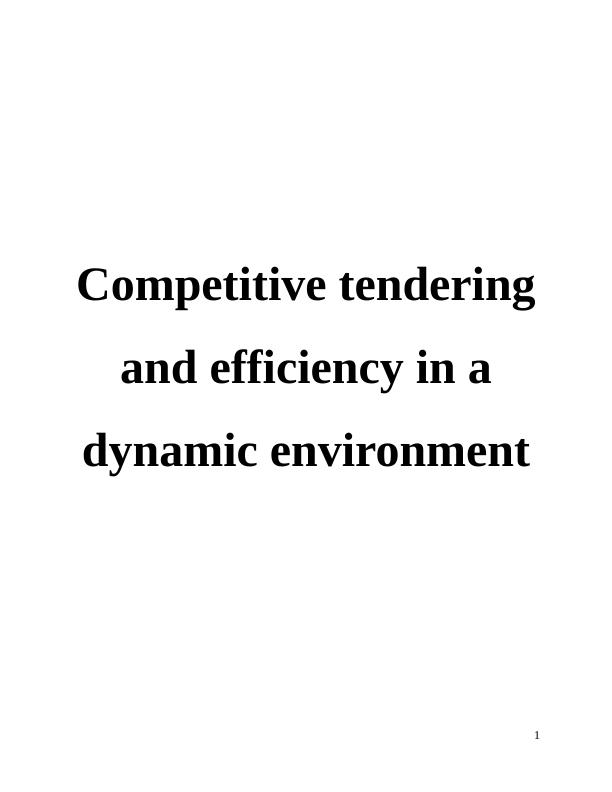
ACKNOWLEDGEMENT
I owe my deepest gratitude to my mentor who inspired and guided me with his wisdom
and knowledge. His commitment to the highest standards motivated me to carry out the entire
dissertation in the right manner. I would like to express sincere thanks to my family members
and friends who provided me immense support throughout the entire research work. I would also
like to thank my colleagues and team members who helped me in gathering the data for the study
and its analysis.
I owe my deepest gratitude to my mentor who inspired and guided me with his wisdom
and knowledge. His commitment to the highest standards motivated me to carry out the entire
dissertation in the right manner. I would like to express sincere thanks to my family members
and friends who provided me immense support throughout the entire research work. I would also
like to thank my colleagues and team members who helped me in gathering the data for the study
and its analysis.
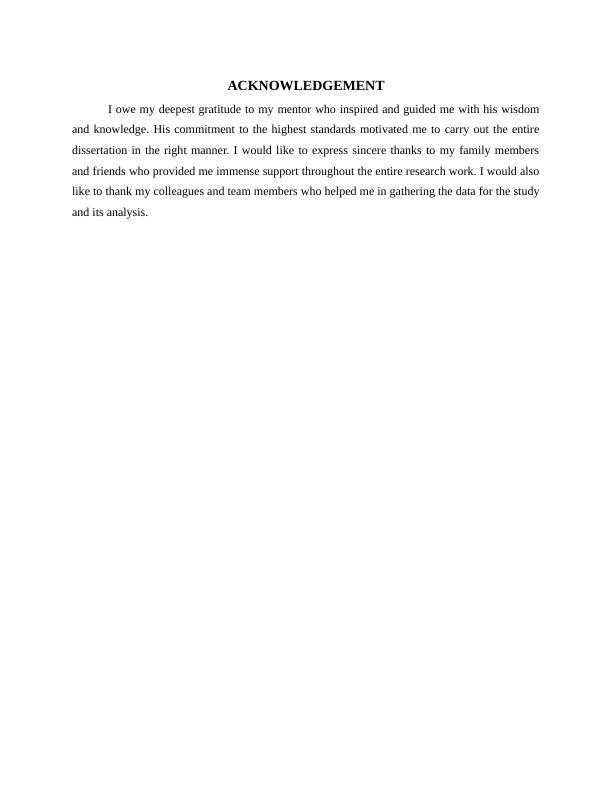
ABSTRACT
Tendering is a process of purchasing the required material and services that is being
needed for carrying out the required functional activities. Uganda is a developing country and
present report aims at exploring the process of tendering as a way of recognizing the competitive
orientation in Ugandan firms. Most of the tenders in the nation are done by public sector
organizations where they largely support in carrying out a successful procedure of bidding. For
carrying out the study qualitative method has been used and thematic technique has been utilized
for conducting the analysis of collected data and information. Data and required information has
been collected from secondary data sources and information available from books, journals and
online sites have been used for completing the study. Non probabilistic sampling has been used
and under this random sampling method has been selected for performing the study. It has been
found that during the financial assessment, all costs should be appropriately covered in the
pricing structure that is being proposed for carrying out the process of bidding. Along with this,
the bids are prepared and by making use of this proposed structure of costing and the currency
conversions are properly covered under the price that is being offered. Bids mentioned over here
are easily comparable and requires conversion to be made on appropriate time. Alternative
costing to meet the specifications are being identified and logged in separately. Details of extra
cost are also evaluated and on whose basis, the terms of payment are determined.
3
Tendering is a process of purchasing the required material and services that is being
needed for carrying out the required functional activities. Uganda is a developing country and
present report aims at exploring the process of tendering as a way of recognizing the competitive
orientation in Ugandan firms. Most of the tenders in the nation are done by public sector
organizations where they largely support in carrying out a successful procedure of bidding. For
carrying out the study qualitative method has been used and thematic technique has been utilized
for conducting the analysis of collected data and information. Data and required information has
been collected from secondary data sources and information available from books, journals and
online sites have been used for completing the study. Non probabilistic sampling has been used
and under this random sampling method has been selected for performing the study. It has been
found that during the financial assessment, all costs should be appropriately covered in the
pricing structure that is being proposed for carrying out the process of bidding. Along with this,
the bids are prepared and by making use of this proposed structure of costing and the currency
conversions are properly covered under the price that is being offered. Bids mentioned over here
are easily comparable and requires conversion to be made on appropriate time. Alternative
costing to meet the specifications are being identified and logged in separately. Details of extra
cost are also evaluated and on whose basis, the terms of payment are determined.
3

TABLE OF CONTENT
ACKNOWLEDGEMENT...............................................................................................................2
ABSTRACT.....................................................................................................................................3
CHAPTER- 1...................................................................................................................................6
INTRODUCTION...........................................................................................................................6
1.1 Background.......................................................................................................................6
1.2 Rationale of the study.......................................................................................................6
1.3 Research aims and objectives...........................................................................................7
Research questions.................................................................................................................7
1.4 Analysis and framework...................................................................................................8
CHAPTER- 2...................................................................................................................................9
LITERATURE REVIEW.................................................................................................................9
2.0 Introduction......................................................................................................................9
2.1 Concept of tendering........................................................................................................9
2.2 Tendering procedure.......................................................................................................13
2.3 External and internal factors influencing the tendering procedure................................18
CHAPTER- 3.................................................................................................................................22
RESEARCH METHODOLOGY...................................................................................................22
3.0 Introduction....................................................................................................................22
3.1 Research philosophy.......................................................................................................22
3.2 Research approach..........................................................................................................23
3.3 Research design..............................................................................................................23
3.4 Data collection................................................................................................................24
3.5 Data analysis...................................................................................................................25
3.6 Validity and reliability....................................................................................................26
3.7 Ethical consideration......................................................................................................26
3.8 Research limitation.........................................................................................................27
CHAPTER- 4.................................................................................................................................28
DATA ANALYSIS AND FINDINGS............................................................................................28
4.0 Introduction....................................................................................................................28
ACKNOWLEDGEMENT...............................................................................................................2
ABSTRACT.....................................................................................................................................3
CHAPTER- 1...................................................................................................................................6
INTRODUCTION...........................................................................................................................6
1.1 Background.......................................................................................................................6
1.2 Rationale of the study.......................................................................................................6
1.3 Research aims and objectives...........................................................................................7
Research questions.................................................................................................................7
1.4 Analysis and framework...................................................................................................8
CHAPTER- 2...................................................................................................................................9
LITERATURE REVIEW.................................................................................................................9
2.0 Introduction......................................................................................................................9
2.1 Concept of tendering........................................................................................................9
2.2 Tendering procedure.......................................................................................................13
2.3 External and internal factors influencing the tendering procedure................................18
CHAPTER- 3.................................................................................................................................22
RESEARCH METHODOLOGY...................................................................................................22
3.0 Introduction....................................................................................................................22
3.1 Research philosophy.......................................................................................................22
3.2 Research approach..........................................................................................................23
3.3 Research design..............................................................................................................23
3.4 Data collection................................................................................................................24
3.5 Data analysis...................................................................................................................25
3.6 Validity and reliability....................................................................................................26
3.7 Ethical consideration......................................................................................................26
3.8 Research limitation.........................................................................................................27
CHAPTER- 4.................................................................................................................................28
DATA ANALYSIS AND FINDINGS............................................................................................28
4.0 Introduction....................................................................................................................28
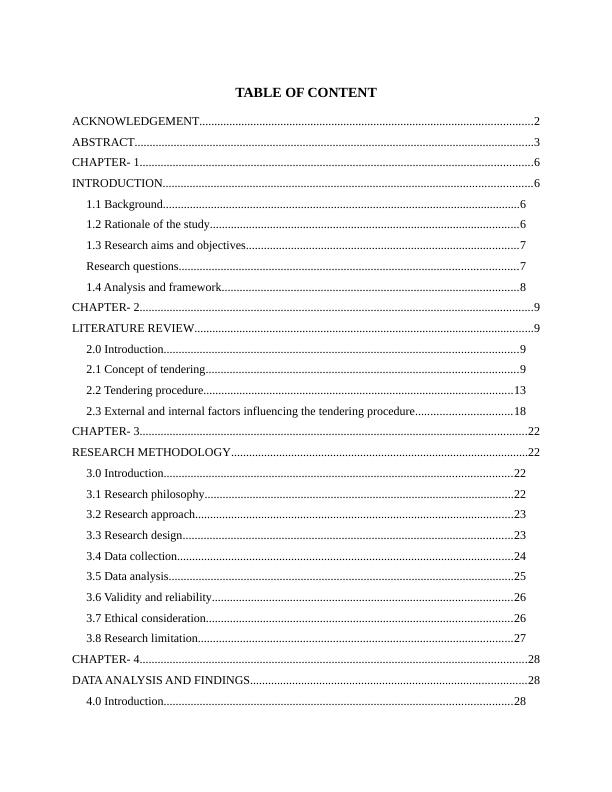
4.1 Thematic and content analysis........................................................................................28
CHAPTER- 5.................................................................................................................................45
CONCLUSION AND RECOMMENDATION.............................................................................45
REFLECTING STATEMENT AND DEVELOPMENT PLAN....................................................50
Research Methods & Processes............................................................................................50
REFERENCES..............................................................................................................................53
5
CHAPTER- 5.................................................................................................................................45
CONCLUSION AND RECOMMENDATION.............................................................................45
REFLECTING STATEMENT AND DEVELOPMENT PLAN....................................................50
Research Methods & Processes............................................................................................50
REFERENCES..............................................................................................................................53
5
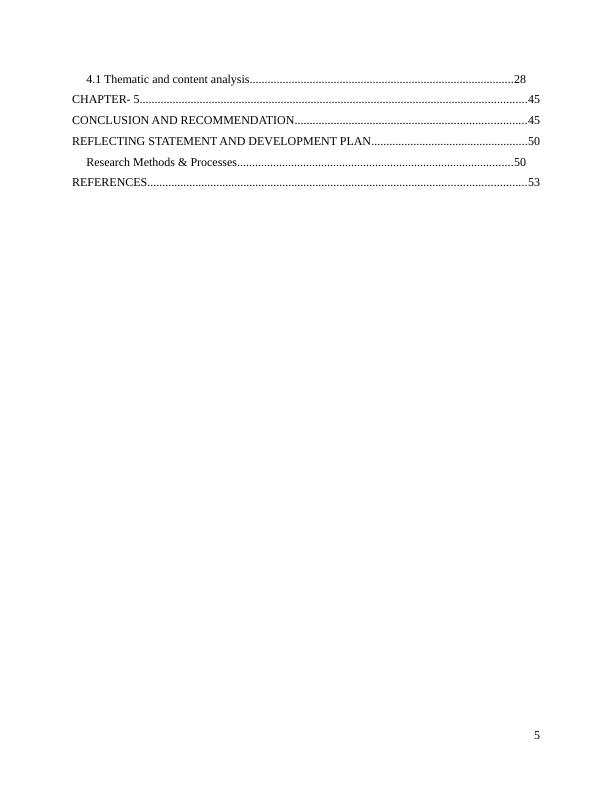
CHAPTER- 1
INTRODUCTION
1.1 Background
It is in context of the undertaken research work that has explored the process of tendering
to recognize its competitive orientation in the Ugandan firms participating in it. Wherein, the
procedure of tendering is referred to be among the most substantial operations of public sector
firms in the developing countries like Uganda. It is A majority of tenders in Uganda are being
undertaken by their governmental bodies that together involves the public bodies by duly
inviting them to participate in the process of bidding. It is however on envisioning the past times,
it has been observed that the tendering procedure in Uganda is becoming a part of corrupted
political parties (Oluka and Basheka, 2014).
As a result to which, it is leading to a poor state of performance where most of the
governmental organisations are failing to abide by the established clauses of tendering by law
(Omotoye, 2016). It is also in context to a modernised environment of business where these
organisations are duly defined by some well defined principles of public private partnership
between the public and private sector firms. It is where the public sector enterprises hereby tend
to support the private firms in Uganda via fiscal assistance (Lindell and Ampaire, 2016).
Wherein, the private sector establishments in turn refer to propose technical assistance with
proficient skills and expertise to acquire a valuable set of data for attaining several numbers of
projects by framing a competitive tender. It often leads to a competitive state of market where the
present investigation has been conducted to analyse the competitive positioning of tendering
process in Ugandan entities operating in public private partnership. It is with a fundamental
context of exploring their present competent positioning among the public- private partnership
ventures.
1.2 Rationale of the study
This section is to specify the factual context of this survey that is conducted to
acknowledge the prevalent state of competition in the tendering process of Ugandan public
private partnership ventures as focused in the present investigation. It is basically to study such
competing state of procurement procedure by broadly investigating an undertaken case of
Ugandan firms. Here, it is together evident that most of the public sector organisations in the
INTRODUCTION
1.1 Background
It is in context of the undertaken research work that has explored the process of tendering
to recognize its competitive orientation in the Ugandan firms participating in it. Wherein, the
procedure of tendering is referred to be among the most substantial operations of public sector
firms in the developing countries like Uganda. It is A majority of tenders in Uganda are being
undertaken by their governmental bodies that together involves the public bodies by duly
inviting them to participate in the process of bidding. It is however on envisioning the past times,
it has been observed that the tendering procedure in Uganda is becoming a part of corrupted
political parties (Oluka and Basheka, 2014).
As a result to which, it is leading to a poor state of performance where most of the
governmental organisations are failing to abide by the established clauses of tendering by law
(Omotoye, 2016). It is also in context to a modernised environment of business where these
organisations are duly defined by some well defined principles of public private partnership
between the public and private sector firms. It is where the public sector enterprises hereby tend
to support the private firms in Uganda via fiscal assistance (Lindell and Ampaire, 2016).
Wherein, the private sector establishments in turn refer to propose technical assistance with
proficient skills and expertise to acquire a valuable set of data for attaining several numbers of
projects by framing a competitive tender. It often leads to a competitive state of market where the
present investigation has been conducted to analyse the competitive positioning of tendering
process in Ugandan entities operating in public private partnership. It is with a fundamental
context of exploring their present competent positioning among the public- private partnership
ventures.
1.2 Rationale of the study
This section is to specify the factual context of this survey that is conducted to
acknowledge the prevalent state of competition in the tendering process of Ugandan public
private partnership ventures as focused in the present investigation. It is basically to study such
competing state of procurement procedure by broadly investigating an undertaken case of
Ugandan firms. Here, it is together evident that most of the public sector organisations in the
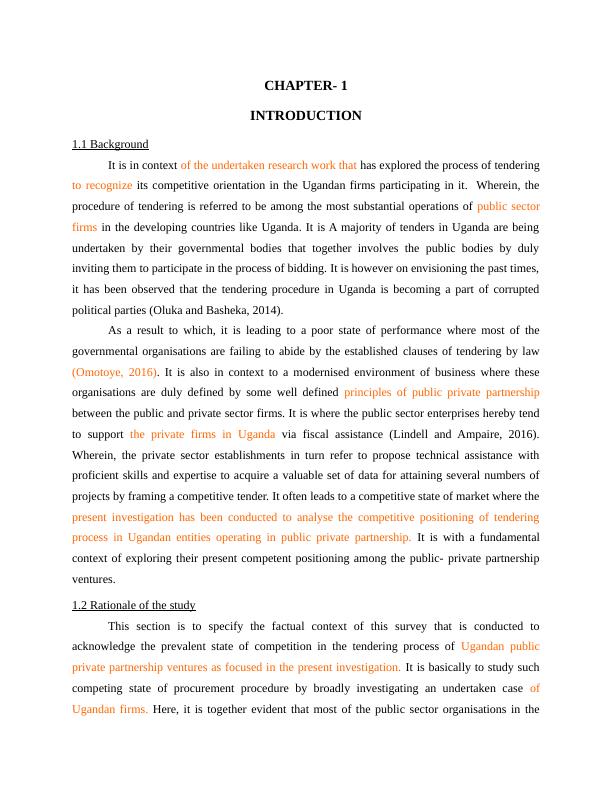
nation are employed with customary tactics to carry out the process of procurement (Atiga and
Azanlerigu, 2017). It however in turn undermines the state of competition by together limiting
the quality of their procurement procedures for not being correspondent to the modern practices
of procurement. It resultantly declines the valuable circumstance of public sector establishments
with a deficit existence of invention required to correspond to today's progressive strategies of
procurement. It has been reflected to be a major problematic concern where most of the Ugandan
enterprises actively participating in the process of tendering are dealing with several number of
clashes for the changing procedures. The present study where it resolution will be done by
studying such vital factors like accountability and transparency in the organisations that in turn
supports in the achievement of a competitive process of procurement.
1.3 Research aims and objectives
A chief aim of this survey is “To examine the tendering process of Ugandan public-
private partnerships firms with a prime intent of determining whether and how it is centred on a
competitive orientation of procurement procedure.”
It is with some definite number of objectives to accomplish the intended goal of this
investigation where these are as referred below-
To determine how the dynamic external and internal factors of environment are driving a
need to increasingly ensure the tendering process is competitive in Uganda.
To determine whether procurement processes in public-private partnerships in Uganda
are competitive, both through adding value to the public sector and the range of tenders
that are available to bid on.
To recommend ways of enhancing competitiveness of the tendering process in Uganda.
Research questions
It is basically to ensure a directional research work with well defined aims and objectives
where the below framed queries will thoroughly guide the surveyor to attain them within a
stipulated time frame-
What is the impact of external and internal factors of environment on the need for having
a competitive tendering process in Uganda?
In what ways are procurement processes in public-private partnerships competitive, and
can they add value to public sector firms?
7
Azanlerigu, 2017). It however in turn undermines the state of competition by together limiting
the quality of their procurement procedures for not being correspondent to the modern practices
of procurement. It resultantly declines the valuable circumstance of public sector establishments
with a deficit existence of invention required to correspond to today's progressive strategies of
procurement. It has been reflected to be a major problematic concern where most of the Ugandan
enterprises actively participating in the process of tendering are dealing with several number of
clashes for the changing procedures. The present study where it resolution will be done by
studying such vital factors like accountability and transparency in the organisations that in turn
supports in the achievement of a competitive process of procurement.
1.3 Research aims and objectives
A chief aim of this survey is “To examine the tendering process of Ugandan public-
private partnerships firms with a prime intent of determining whether and how it is centred on a
competitive orientation of procurement procedure.”
It is with some definite number of objectives to accomplish the intended goal of this
investigation where these are as referred below-
To determine how the dynamic external and internal factors of environment are driving a
need to increasingly ensure the tendering process is competitive in Uganda.
To determine whether procurement processes in public-private partnerships in Uganda
are competitive, both through adding value to the public sector and the range of tenders
that are available to bid on.
To recommend ways of enhancing competitiveness of the tendering process in Uganda.
Research questions
It is basically to ensure a directional research work with well defined aims and objectives
where the below framed queries will thoroughly guide the surveyor to attain them within a
stipulated time frame-
What is the impact of external and internal factors of environment on the need for having
a competitive tendering process in Uganda?
In what ways are procurement processes in public-private partnerships competitive, and
can they add value to public sector firms?
7
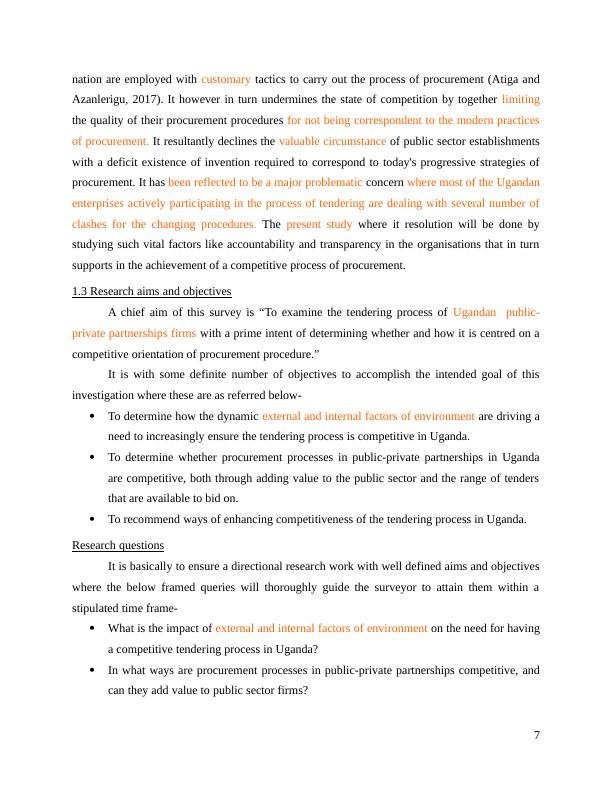
What ways could be used to enhance the competitiveness of tendering processes in
Ugandan public private partnership firms?
1.4 Analysis and framework
It is mainly in context to an owing significance of procurement procedures for the overall
development of the nation, there existed a prompt requisition of determining the level of
competition in the procurement procedure of public-private partnerships firms. It is with another
principle identification of the role that can be played by these partnerships to augment the state
of a valuable competition with the public sector by a pertinent process of procurement (Osei–
Kyei and Chan, 2016). Furthermore, this research work has together referred to analyse a prime
intervention of assorted driving forces like the existent extraneous and supply chains to fund into
the big projects. This involves IMF, World Bank, etc., with a major consent of funding in the big
projects carried out in developing nations like Uganda. Consequently, this assessment is apparent
to come up with certain effective ways to enhance the level of competition in the tendering
process of Uganda. After whose implementation, it will considerably contribute into their overall
agenda of acquiring a competitive procurement process.
For which, the investigator has hereby referred to opt for the secondary research methods
accompanied by various secondary sources gathered from genuine set of books, journals, online
publications and magazines, etc. It has together depicted a case study approach undertaken by the
researcher as a way of analysing the procurement procedure in the field of supply chain
management in Uganda and other South African nations. Where these obtained facts and findings
have been reflected in the section of literature review. In concord to which, it has together
depicted an exploratory research approach undertaken by the investigator with a non
probabilistic tact of sampling. Wherein, the experts of two different companies in Uganda have
been interrogated with the help of qualitative analysis to further evaluate the acquired
information from them and conduct a thematic assessment of the same.
Ugandan public private partnership firms?
1.4 Analysis and framework
It is mainly in context to an owing significance of procurement procedures for the overall
development of the nation, there existed a prompt requisition of determining the level of
competition in the procurement procedure of public-private partnerships firms. It is with another
principle identification of the role that can be played by these partnerships to augment the state
of a valuable competition with the public sector by a pertinent process of procurement (Osei–
Kyei and Chan, 2016). Furthermore, this research work has together referred to analyse a prime
intervention of assorted driving forces like the existent extraneous and supply chains to fund into
the big projects. This involves IMF, World Bank, etc., with a major consent of funding in the big
projects carried out in developing nations like Uganda. Consequently, this assessment is apparent
to come up with certain effective ways to enhance the level of competition in the tendering
process of Uganda. After whose implementation, it will considerably contribute into their overall
agenda of acquiring a competitive procurement process.
For which, the investigator has hereby referred to opt for the secondary research methods
accompanied by various secondary sources gathered from genuine set of books, journals, online
publications and magazines, etc. It has together depicted a case study approach undertaken by the
researcher as a way of analysing the procurement procedure in the field of supply chain
management in Uganda and other South African nations. Where these obtained facts and findings
have been reflected in the section of literature review. In concord to which, it has together
depicted an exploratory research approach undertaken by the investigator with a non
probabilistic tact of sampling. Wherein, the experts of two different companies in Uganda have
been interrogated with the help of qualitative analysis to further evaluate the acquired
information from them and conduct a thematic assessment of the same.
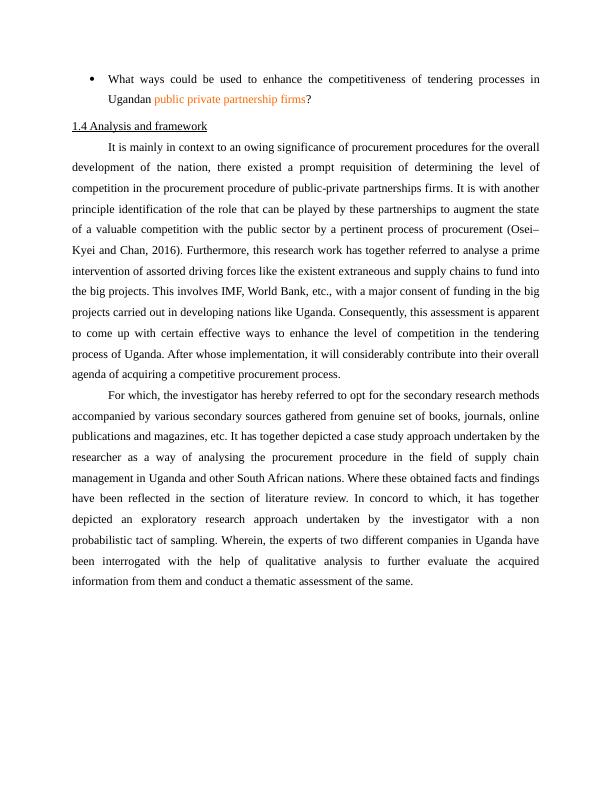
End of preview
Want to access all the pages? Upload your documents or become a member.
Related Documents
Information Technology on Marketing : case study of ASDAlg...
|58
|18579
|44
Case Study on impact of social media marketing strategy : Marks and Spencerlg...
|66
|20667
|73
Logistics and Supply Chain Managementlg...
|37
|10191
|458
Effect of Motivation on Employee Performance - AG913lg...
|52
|12439
|830
Impact of Digital Marketing on Consumer Behaviour Reportlg...
|38
|8943
|288
Boosting Customer Satisfaction in the Hotel Industry of Thailand: An Examination of Strategieslg...
|71
|30819
|76
